Operations and Project Management: Tesco Case Study - HNBS 316 Report
VerifiedAdded on 2023/06/12
|19
|5843
|124
Report
AI Summary
This report provides a comprehensive analysis of operations and project management within Tesco, a British multinational groceries retailer. It begins by differentiating between 'operation' and 'operations management,' highlighting key operational functions at Tesco, such as store administration, inventory management, and customer service. The report reviews and critiques Tesco's implementation of operations management principles, discussing strengths and limitations in areas like inbound/outbound logistics and flexible specialization. It assesses how well Tesco's operations management meets organizational requirements, particularly in revenue generation, product/service production, and work standardization. Furthermore, the report discusses continuous improvement plans, evaluating the effectiveness of Six Sigma and Just in Time approaches. The second part of the report delves into project management, focusing on the Product Life Cycle (PLC) and analyzing project methodologies. It critically evaluates the effectiveness of PLC in application to projects, using models and concepts to enhance understanding. This document is available on Desklib, a platform offering a wealth of study resources for students.
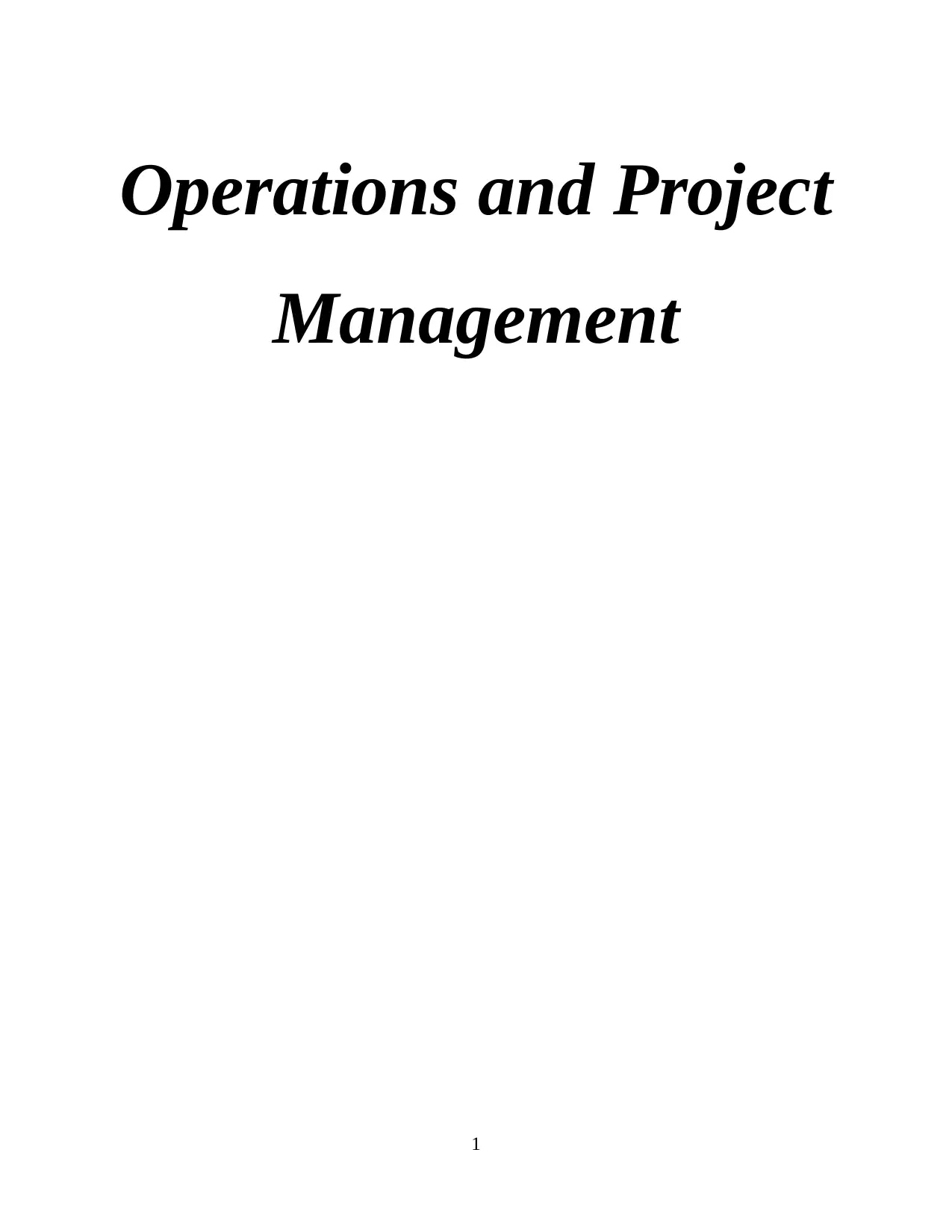
Operations and Project
Management
1
Management
1
Paraphrase This Document
Need a fresh take? Get an instant paraphrase of this document with our AI Paraphraser
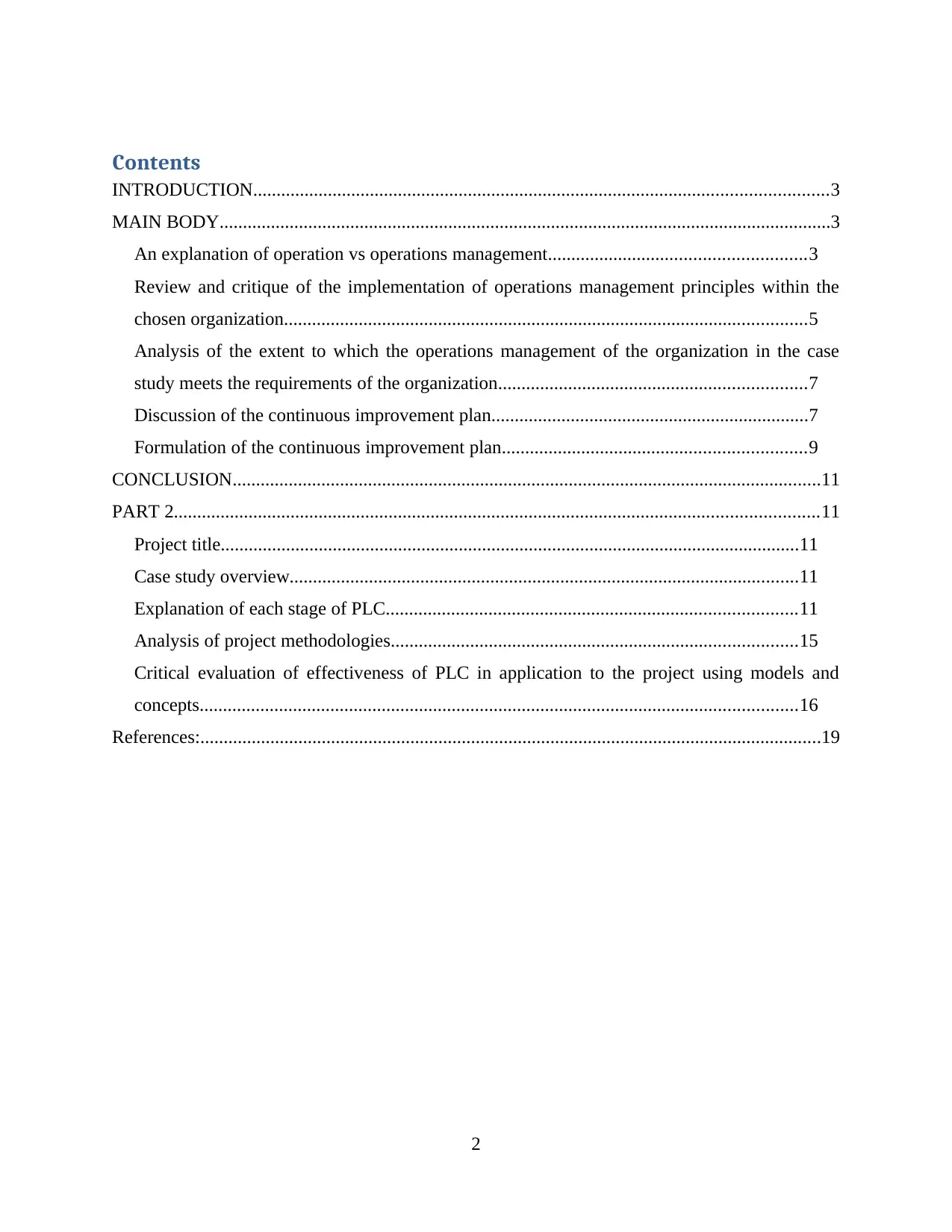
Contents
INTRODUCTION...........................................................................................................................3
MAIN BODY...................................................................................................................................3
An explanation of operation vs operations management.......................................................3
Review and critique of the implementation of operations management principles within the
chosen organization................................................................................................................5
Analysis of the extent to which the operations management of the organization in the case
study meets the requirements of the organization..................................................................7
Discussion of the continuous improvement plan....................................................................7
Formulation of the continuous improvement plan.................................................................9
CONCLUSION..............................................................................................................................11
PART 2..........................................................................................................................................11
Project title............................................................................................................................11
Case study overview.............................................................................................................11
Explanation of each stage of PLC........................................................................................11
Analysis of project methodologies.......................................................................................15
Critical evaluation of effectiveness of PLC in application to the project using models and
concepts................................................................................................................................16
References:.....................................................................................................................................19
2
INTRODUCTION...........................................................................................................................3
MAIN BODY...................................................................................................................................3
An explanation of operation vs operations management.......................................................3
Review and critique of the implementation of operations management principles within the
chosen organization................................................................................................................5
Analysis of the extent to which the operations management of the organization in the case
study meets the requirements of the organization..................................................................7
Discussion of the continuous improvement plan....................................................................7
Formulation of the continuous improvement plan.................................................................9
CONCLUSION..............................................................................................................................11
PART 2..........................................................................................................................................11
Project title............................................................................................................................11
Case study overview.............................................................................................................11
Explanation of each stage of PLC........................................................................................11
Analysis of project methodologies.......................................................................................15
Critical evaluation of effectiveness of PLC in application to the project using models and
concepts................................................................................................................................16
References:.....................................................................................................................................19
2
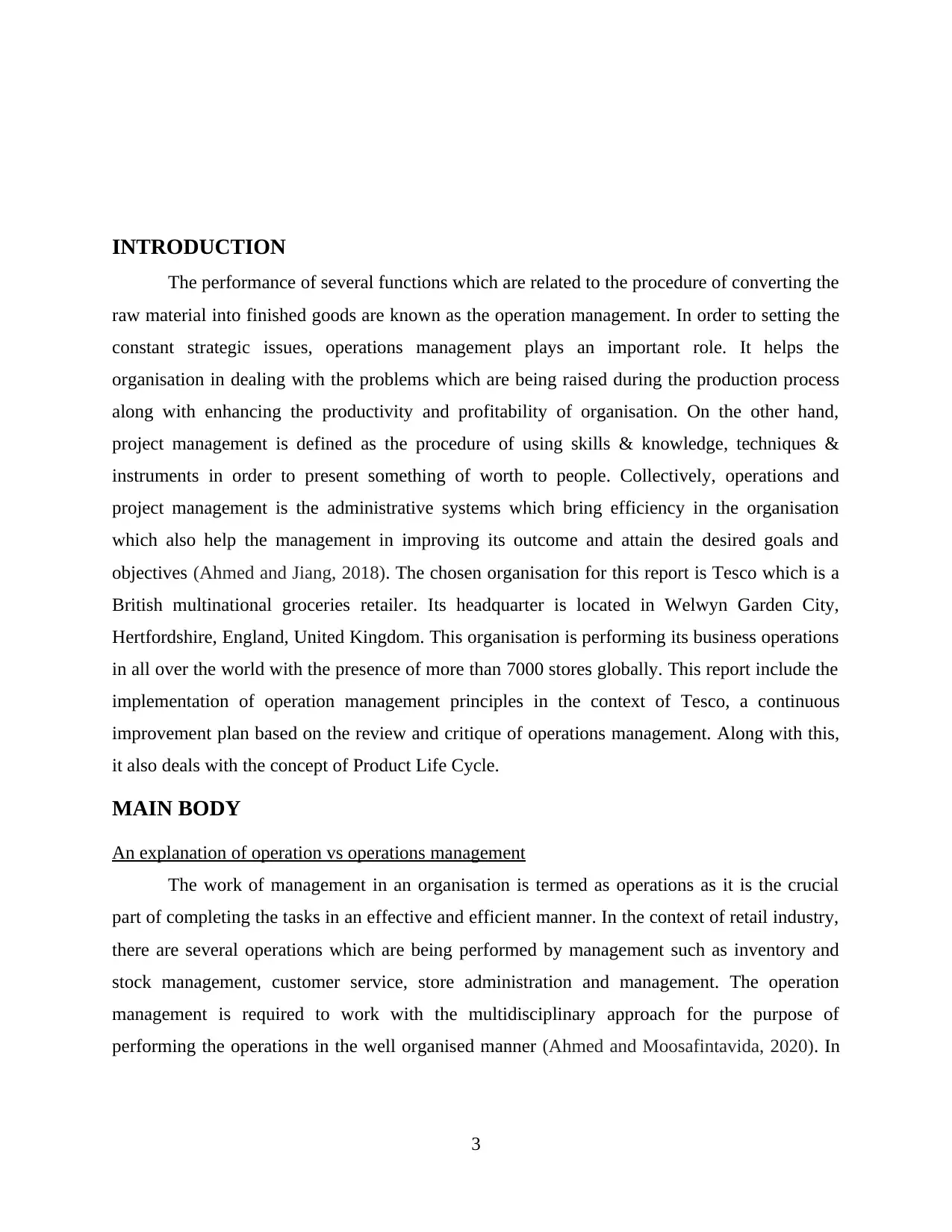
INTRODUCTION
The performance of several functions which are related to the procedure of converting the
raw material into finished goods are known as the operation management. In order to setting the
constant strategic issues, operations management plays an important role. It helps the
organisation in dealing with the problems which are being raised during the production process
along with enhancing the productivity and profitability of organisation. On the other hand,
project management is defined as the procedure of using skills & knowledge, techniques &
instruments in order to present something of worth to people. Collectively, operations and
project management is the administrative systems which bring efficiency in the organisation
which also help the management in improving its outcome and attain the desired goals and
objectives (Ahmed and Jiang, 2018). The chosen organisation for this report is Tesco which is a
British multinational groceries retailer. Its headquarter is located in Welwyn Garden City,
Hertfordshire, England, United Kingdom. This organisation is performing its business operations
in all over the world with the presence of more than 7000 stores globally. This report include the
implementation of operation management principles in the context of Tesco, a continuous
improvement plan based on the review and critique of operations management. Along with this,
it also deals with the concept of Product Life Cycle.
MAIN BODY
An explanation of operation vs operations management
The work of management in an organisation is termed as operations as it is the crucial
part of completing the tasks in an effective and efficient manner. In the context of retail industry,
there are several operations which are being performed by management such as inventory and
stock management, customer service, store administration and management. The operation
management is required to work with the multidisciplinary approach for the purpose of
performing the operations in the well organised manner (Ahmed and Moosafintavida, 2020). In
3
The performance of several functions which are related to the procedure of converting the
raw material into finished goods are known as the operation management. In order to setting the
constant strategic issues, operations management plays an important role. It helps the
organisation in dealing with the problems which are being raised during the production process
along with enhancing the productivity and profitability of organisation. On the other hand,
project management is defined as the procedure of using skills & knowledge, techniques &
instruments in order to present something of worth to people. Collectively, operations and
project management is the administrative systems which bring efficiency in the organisation
which also help the management in improving its outcome and attain the desired goals and
objectives (Ahmed and Jiang, 2018). The chosen organisation for this report is Tesco which is a
British multinational groceries retailer. Its headquarter is located in Welwyn Garden City,
Hertfordshire, England, United Kingdom. This organisation is performing its business operations
in all over the world with the presence of more than 7000 stores globally. This report include the
implementation of operation management principles in the context of Tesco, a continuous
improvement plan based on the review and critique of operations management. Along with this,
it also deals with the concept of Product Life Cycle.
MAIN BODY
An explanation of operation vs operations management
The work of management in an organisation is termed as operations as it is the crucial
part of completing the tasks in an effective and efficient manner. In the context of retail industry,
there are several operations which are being performed by management such as inventory and
stock management, customer service, store administration and management. The operation
management is required to work with the multidisciplinary approach for the purpose of
performing the operations in the well organised manner (Ahmed and Moosafintavida, 2020). In
3
⊘ This is a preview!⊘
Do you want full access?
Subscribe today to unlock all pages.

Trusted by 1+ million students worldwide
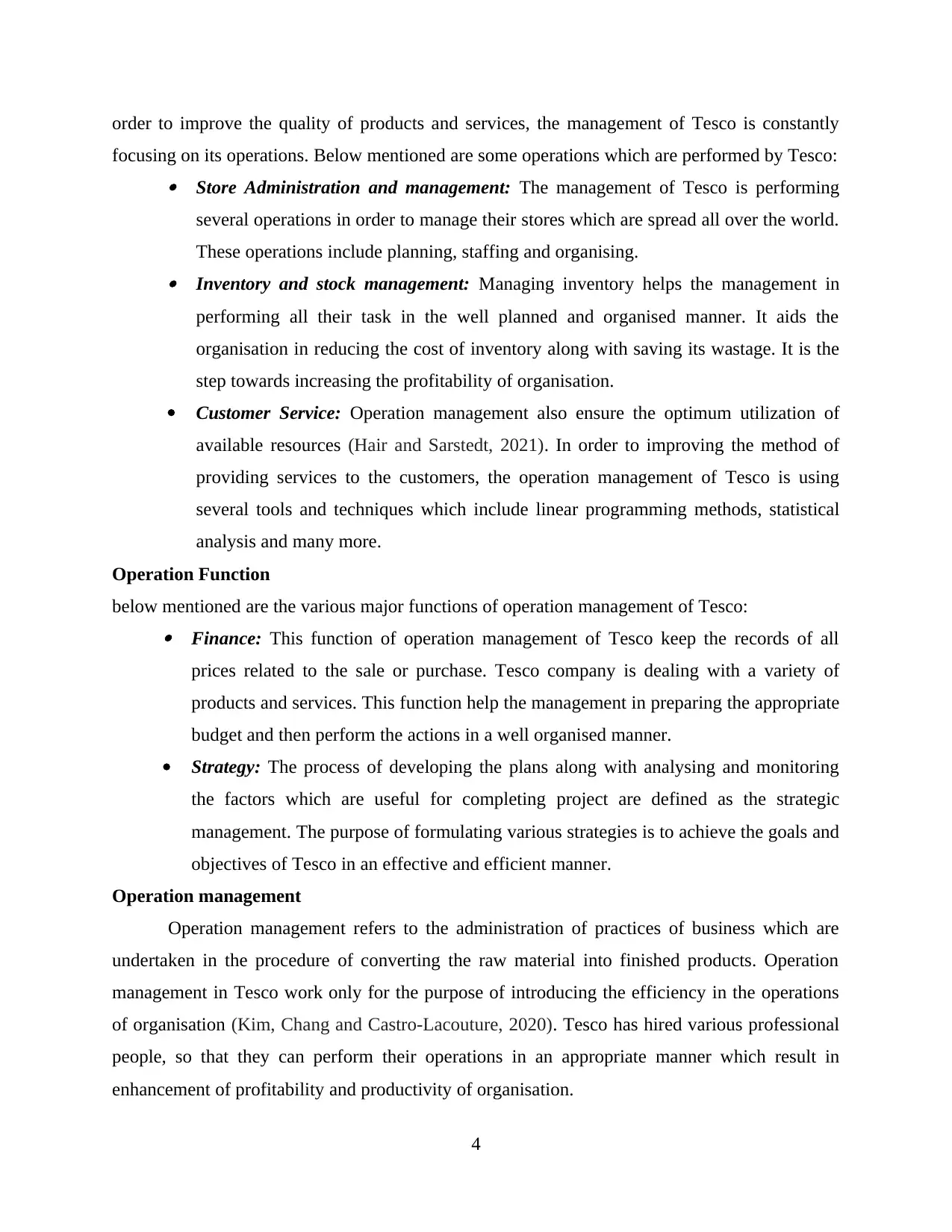
order to improve the quality of products and services, the management of Tesco is constantly
focusing on its operations. Below mentioned are some operations which are performed by Tesco:
Store Administration and management: The management of Tesco is performing
several operations in order to manage their stores which are spread all over the world.
These operations include planning, staffing and organising.
Inventory and stock management: Managing inventory helps the management in
performing all their task in the well planned and organised manner. It aids the
organisation in reducing the cost of inventory along with saving its wastage. It is the
step towards increasing the profitability of organisation.
Customer Service: Operation management also ensure the optimum utilization of
available resources (Hair and Sarstedt, 2021). In order to improving the method of
providing services to the customers, the operation management of Tesco is using
several tools and techniques which include linear programming methods, statistical
analysis and many more.
Operation Function
below mentioned are the various major functions of operation management of Tesco:
Finance: This function of operation management of Tesco keep the records of all
prices related to the sale or purchase. Tesco company is dealing with a variety of
products and services. This function help the management in preparing the appropriate
budget and then perform the actions in a well organised manner.
Strategy: The process of developing the plans along with analysing and monitoring
the factors which are useful for completing project are defined as the strategic
management. The purpose of formulating various strategies is to achieve the goals and
objectives of Tesco in an effective and efficient manner.
Operation management
Operation management refers to the administration of practices of business which are
undertaken in the procedure of converting the raw material into finished products. Operation
management in Tesco work only for the purpose of introducing the efficiency in the operations
of organisation (Kim, Chang and Castro-Lacouture, 2020). Tesco has hired various professional
people, so that they can perform their operations in an appropriate manner which result in
enhancement of profitability and productivity of organisation.
4
focusing on its operations. Below mentioned are some operations which are performed by Tesco:
Store Administration and management: The management of Tesco is performing
several operations in order to manage their stores which are spread all over the world.
These operations include planning, staffing and organising.
Inventory and stock management: Managing inventory helps the management in
performing all their task in the well planned and organised manner. It aids the
organisation in reducing the cost of inventory along with saving its wastage. It is the
step towards increasing the profitability of organisation.
Customer Service: Operation management also ensure the optimum utilization of
available resources (Hair and Sarstedt, 2021). In order to improving the method of
providing services to the customers, the operation management of Tesco is using
several tools and techniques which include linear programming methods, statistical
analysis and many more.
Operation Function
below mentioned are the various major functions of operation management of Tesco:
Finance: This function of operation management of Tesco keep the records of all
prices related to the sale or purchase. Tesco company is dealing with a variety of
products and services. This function help the management in preparing the appropriate
budget and then perform the actions in a well organised manner.
Strategy: The process of developing the plans along with analysing and monitoring
the factors which are useful for completing project are defined as the strategic
management. The purpose of formulating various strategies is to achieve the goals and
objectives of Tesco in an effective and efficient manner.
Operation management
Operation management refers to the administration of practices of business which are
undertaken in the procedure of converting the raw material into finished products. Operation
management in Tesco work only for the purpose of introducing the efficiency in the operations
of organisation (Kim, Chang and Castro-Lacouture, 2020). Tesco has hired various professional
people, so that they can perform their operations in an appropriate manner which result in
enhancement of profitability and productivity of organisation.
4
Paraphrase This Document
Need a fresh take? Get an instant paraphrase of this document with our AI Paraphraser
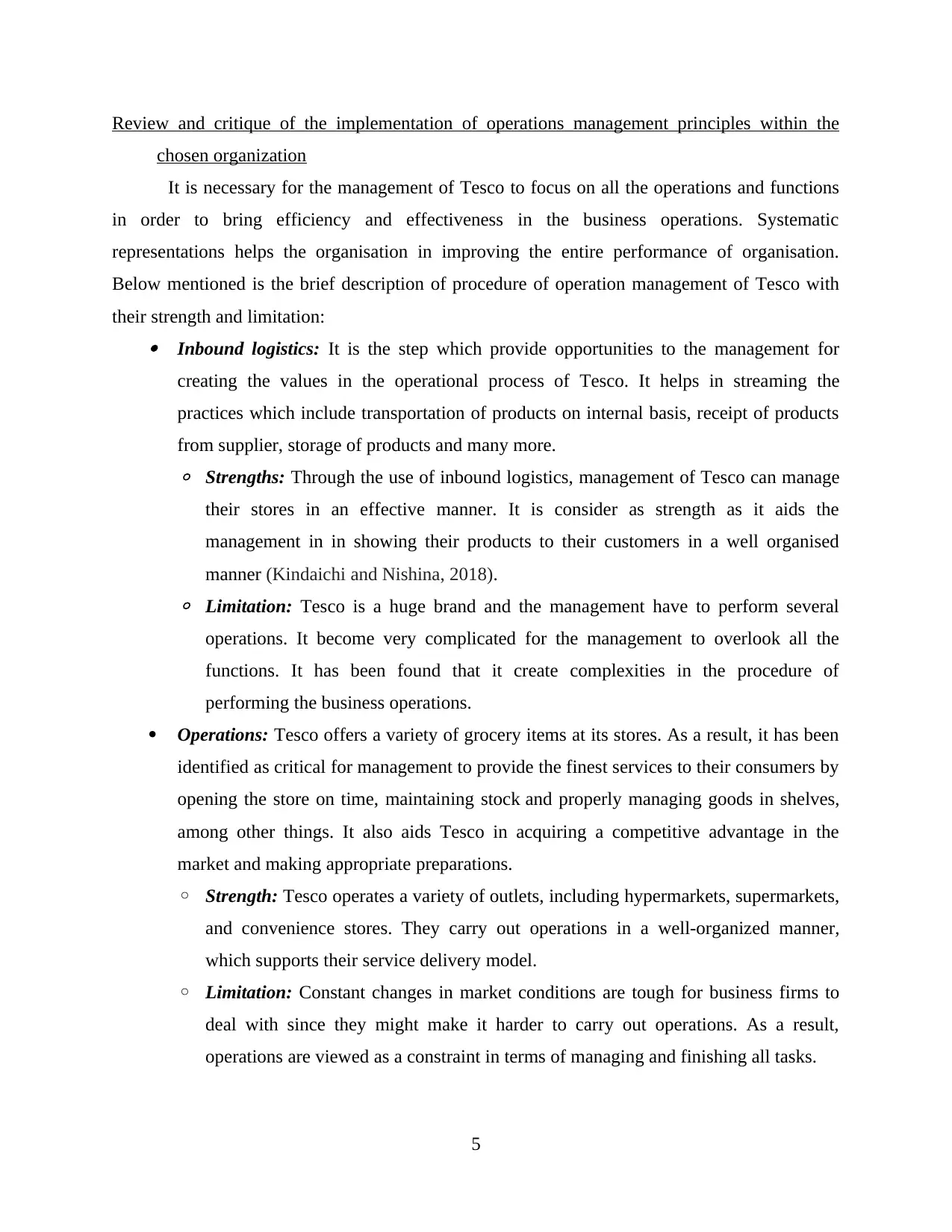
Review and critique of the implementation of operations management principles within the
chosen organization
It is necessary for the management of Tesco to focus on all the operations and functions
in order to bring efficiency and effectiveness in the business operations. Systematic
representations helps the organisation in improving the entire performance of organisation.
Below mentioned is the brief description of procedure of operation management of Tesco with
their strength and limitation: Inbound logistics: It is the step which provide opportunities to the management for
creating the values in the operational process of Tesco. It helps in streaming the
practices which include transportation of products on internal basis, receipt of products
from supplier, storage of products and many more.
◦ Strengths: Through the use of inbound logistics, management of Tesco can manage
their stores in an effective manner. It is consider as strength as it aids the
management in in showing their products to their customers in a well organised
manner (Kindaichi and Nishina, 2018).
◦ Limitation: Tesco is a huge brand and the management have to perform several
operations. It become very complicated for the management to overlook all the
functions. It has been found that it create complexities in the procedure of
performing the business operations.
Operations: Tesco offers a variety of grocery items at its stores. As a result, it has been
identified as critical for management to provide the finest services to their consumers by
opening the store on time, maintaining stock and properly managing goods in shelves,
among other things. It also aids Tesco in acquiring a competitive advantage in the
market and making appropriate preparations.
◦ Strength: Tesco operates a variety of outlets, including hypermarkets, supermarkets,
and convenience stores. They carry out operations in a well-organized manner,
which supports their service delivery model.
◦ Limitation: Constant changes in market conditions are tough for business firms to
deal with since they might make it harder to carry out operations. As a result,
operations are viewed as a constraint in terms of managing and finishing all tasks.
5
chosen organization
It is necessary for the management of Tesco to focus on all the operations and functions
in order to bring efficiency and effectiveness in the business operations. Systematic
representations helps the organisation in improving the entire performance of organisation.
Below mentioned is the brief description of procedure of operation management of Tesco with
their strength and limitation: Inbound logistics: It is the step which provide opportunities to the management for
creating the values in the operational process of Tesco. It helps in streaming the
practices which include transportation of products on internal basis, receipt of products
from supplier, storage of products and many more.
◦ Strengths: Through the use of inbound logistics, management of Tesco can manage
their stores in an effective manner. It is consider as strength as it aids the
management in in showing their products to their customers in a well organised
manner (Kindaichi and Nishina, 2018).
◦ Limitation: Tesco is a huge brand and the management have to perform several
operations. It become very complicated for the management to overlook all the
functions. It has been found that it create complexities in the procedure of
performing the business operations.
Operations: Tesco offers a variety of grocery items at its stores. As a result, it has been
identified as critical for management to provide the finest services to their consumers by
opening the store on time, maintaining stock and properly managing goods in shelves,
among other things. It also aids Tesco in acquiring a competitive advantage in the
market and making appropriate preparations.
◦ Strength: Tesco operates a variety of outlets, including hypermarkets, supermarkets,
and convenience stores. They carry out operations in a well-organized manner,
which supports their service delivery model.
◦ Limitation: Constant changes in market conditions are tough for business firms to
deal with since they might make it harder to carry out operations. As a result,
operations are viewed as a constraint in terms of managing and finishing all tasks.
5
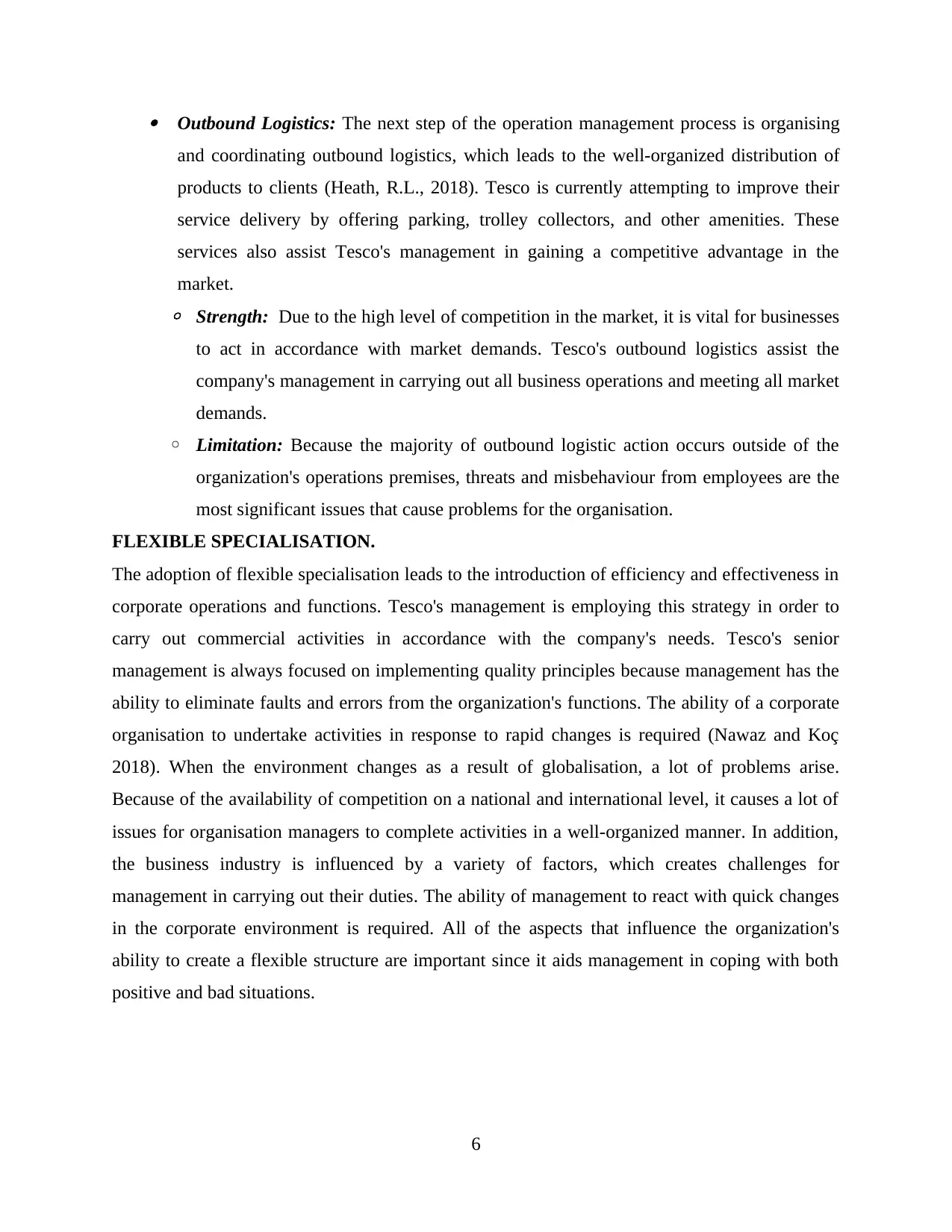
Outbound Logistics: The next step of the operation management process is organising
and coordinating outbound logistics, which leads to the well-organized distribution of
products to clients (Heath, R.L., 2018). Tesco is currently attempting to improve their
service delivery by offering parking, trolley collectors, and other amenities. These
services also assist Tesco's management in gaining a competitive advantage in the
market.
◦ Strength: Due to the high level of competition in the market, it is vital for businesses
to act in accordance with market demands. Tesco's outbound logistics assist the
company's management in carrying out all business operations and meeting all market
demands.
◦ Limitation: Because the majority of outbound logistic action occurs outside of the
organization's operations premises, threats and misbehaviour from employees are the
most significant issues that cause problems for the organisation.
FLEXIBLE SPECIALISATION.
The adoption of flexible specialisation leads to the introduction of efficiency and effectiveness in
corporate operations and functions. Tesco's management is employing this strategy in order to
carry out commercial activities in accordance with the company's needs. Tesco's senior
management is always focused on implementing quality principles because management has the
ability to eliminate faults and errors from the organization's functions. The ability of a corporate
organisation to undertake activities in response to rapid changes is required (Nawaz and Koç
2018). When the environment changes as a result of globalisation, a lot of problems arise.
Because of the availability of competition on a national and international level, it causes a lot of
issues for organisation managers to complete activities in a well-organized manner. In addition,
the business industry is influenced by a variety of factors, which creates challenges for
management in carrying out their duties. The ability of management to react with quick changes
in the corporate environment is required. All of the aspects that influence the organization's
ability to create a flexible structure are important since it aids management in coping with both
positive and bad situations.
6
and coordinating outbound logistics, which leads to the well-organized distribution of
products to clients (Heath, R.L., 2018). Tesco is currently attempting to improve their
service delivery by offering parking, trolley collectors, and other amenities. These
services also assist Tesco's management in gaining a competitive advantage in the
market.
◦ Strength: Due to the high level of competition in the market, it is vital for businesses
to act in accordance with market demands. Tesco's outbound logistics assist the
company's management in carrying out all business operations and meeting all market
demands.
◦ Limitation: Because the majority of outbound logistic action occurs outside of the
organization's operations premises, threats and misbehaviour from employees are the
most significant issues that cause problems for the organisation.
FLEXIBLE SPECIALISATION.
The adoption of flexible specialisation leads to the introduction of efficiency and effectiveness in
corporate operations and functions. Tesco's management is employing this strategy in order to
carry out commercial activities in accordance with the company's needs. Tesco's senior
management is always focused on implementing quality principles because management has the
ability to eliminate faults and errors from the organization's functions. The ability of a corporate
organisation to undertake activities in response to rapid changes is required (Nawaz and Koç
2018). When the environment changes as a result of globalisation, a lot of problems arise.
Because of the availability of competition on a national and international level, it causes a lot of
issues for organisation managers to complete activities in a well-organized manner. In addition,
the business industry is influenced by a variety of factors, which creates challenges for
management in carrying out their duties. The ability of management to react with quick changes
in the corporate environment is required. All of the aspects that influence the organization's
ability to create a flexible structure are important since it aids management in coping with both
positive and bad situations.
6
⊘ This is a preview!⊘
Do you want full access?
Subscribe today to unlock all pages.

Trusted by 1+ million students worldwide
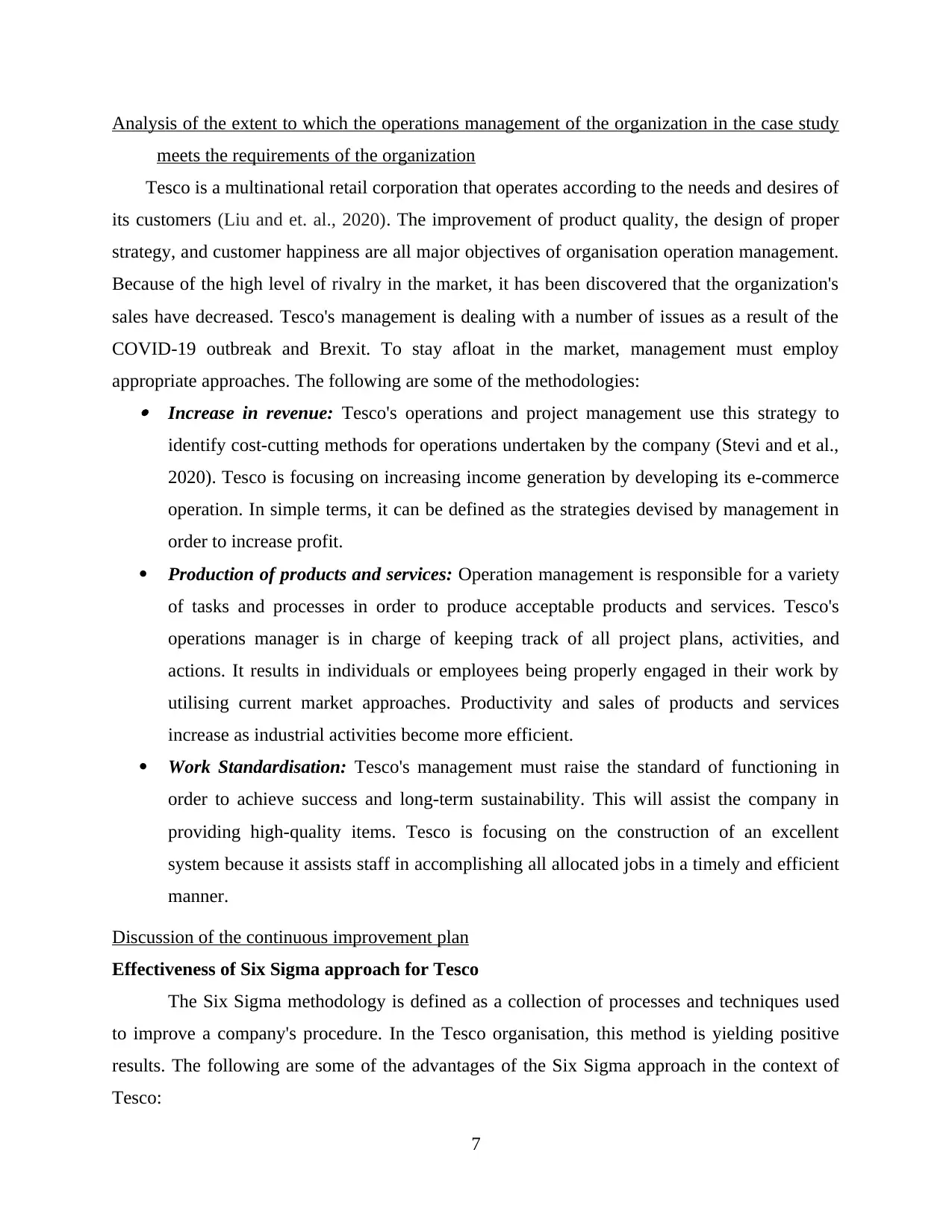
Analysis of the extent to which the operations management of the organization in the case study
meets the requirements of the organization
Tesco is a multinational retail corporation that operates according to the needs and desires of
its customers (Liu and et. al., 2020). The improvement of product quality, the design of proper
strategy, and customer happiness are all major objectives of organisation operation management.
Because of the high level of rivalry in the market, it has been discovered that the organization's
sales have decreased. Tesco's management is dealing with a number of issues as a result of the
COVID-19 outbreak and Brexit. To stay afloat in the market, management must employ
appropriate approaches. The following are some of the methodologies: Increase in revenue: Tesco's operations and project management use this strategy to
identify cost-cutting methods for operations undertaken by the company (Stevi and et al.,
2020). Tesco is focusing on increasing income generation by developing its e-commerce
operation. In simple terms, it can be defined as the strategies devised by management in
order to increase profit.
Production of products and services: Operation management is responsible for a variety
of tasks and processes in order to produce acceptable products and services. Tesco's
operations manager is in charge of keeping track of all project plans, activities, and
actions. It results in individuals or employees being properly engaged in their work by
utilising current market approaches. Productivity and sales of products and services
increase as industrial activities become more efficient.
Work Standardisation: Tesco's management must raise the standard of functioning in
order to achieve success and long-term sustainability. This will assist the company in
providing high-quality items. Tesco is focusing on the construction of an excellent
system because it assists staff in accomplishing all allocated jobs in a timely and efficient
manner.
Discussion of the continuous improvement plan
Effectiveness of Six Sigma approach for Tesco
The Six Sigma methodology is defined as a collection of processes and techniques used
to improve a company's procedure. In the Tesco organisation, this method is yielding positive
results. The following are some of the advantages of the Six Sigma approach in the context of
Tesco:
7
meets the requirements of the organization
Tesco is a multinational retail corporation that operates according to the needs and desires of
its customers (Liu and et. al., 2020). The improvement of product quality, the design of proper
strategy, and customer happiness are all major objectives of organisation operation management.
Because of the high level of rivalry in the market, it has been discovered that the organization's
sales have decreased. Tesco's management is dealing with a number of issues as a result of the
COVID-19 outbreak and Brexit. To stay afloat in the market, management must employ
appropriate approaches. The following are some of the methodologies: Increase in revenue: Tesco's operations and project management use this strategy to
identify cost-cutting methods for operations undertaken by the company (Stevi and et al.,
2020). Tesco is focusing on increasing income generation by developing its e-commerce
operation. In simple terms, it can be defined as the strategies devised by management in
order to increase profit.
Production of products and services: Operation management is responsible for a variety
of tasks and processes in order to produce acceptable products and services. Tesco's
operations manager is in charge of keeping track of all project plans, activities, and
actions. It results in individuals or employees being properly engaged in their work by
utilising current market approaches. Productivity and sales of products and services
increase as industrial activities become more efficient.
Work Standardisation: Tesco's management must raise the standard of functioning in
order to achieve success and long-term sustainability. This will assist the company in
providing high-quality items. Tesco is focusing on the construction of an excellent
system because it assists staff in accomplishing all allocated jobs in a timely and efficient
manner.
Discussion of the continuous improvement plan
Effectiveness of Six Sigma approach for Tesco
The Six Sigma methodology is defined as a collection of processes and techniques used
to improve a company's procedure. In the Tesco organisation, this method is yielding positive
results. The following are some of the advantages of the Six Sigma approach in the context of
Tesco:
7
Paraphrase This Document
Need a fresh take? Get an instant paraphrase of this document with our AI Paraphraser
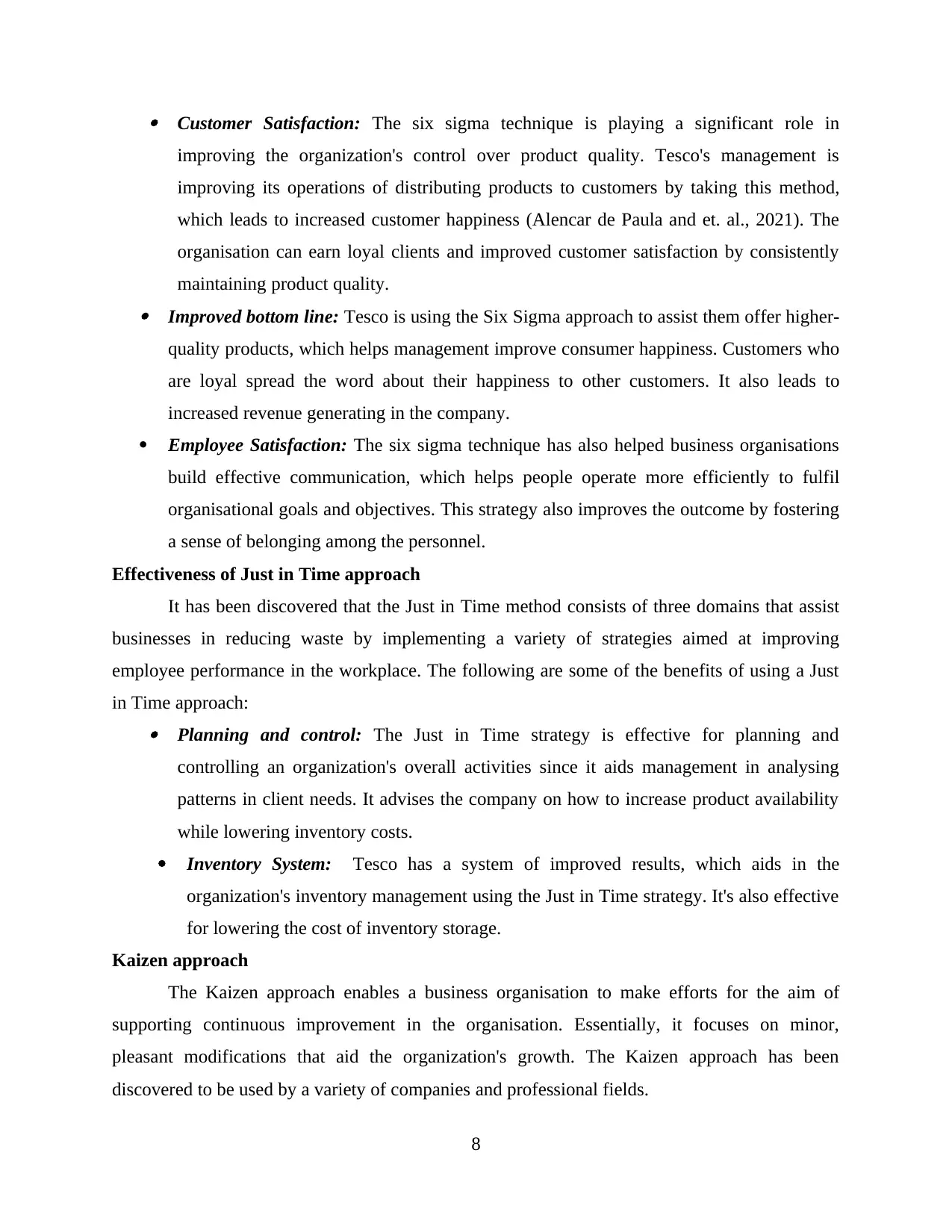
Customer Satisfaction: The six sigma technique is playing a significant role in
improving the organization's control over product quality. Tesco's management is
improving its operations of distributing products to customers by taking this method,
which leads to increased customer happiness (Alencar de Paula and et. al., 2021). The
organisation can earn loyal clients and improved customer satisfaction by consistently
maintaining product quality. Improved bottom line: Tesco is using the Six Sigma approach to assist them offer higher-
quality products, which helps management improve consumer happiness. Customers who
are loyal spread the word about their happiness to other customers. It also leads to
increased revenue generating in the company.
Employee Satisfaction: The six sigma technique has also helped business organisations
build effective communication, which helps people operate more efficiently to fulfil
organisational goals and objectives. This strategy also improves the outcome by fostering
a sense of belonging among the personnel.
Effectiveness of Just in Time approach
It has been discovered that the Just in Time method consists of three domains that assist
businesses in reducing waste by implementing a variety of strategies aimed at improving
employee performance in the workplace. The following are some of the benefits of using a Just
in Time approach: Planning and control: The Just in Time strategy is effective for planning and
controlling an organization's overall activities since it aids management in analysing
patterns in client needs. It advises the company on how to increase product availability
while lowering inventory costs.
Inventory System: Tesco has a system of improved results, which aids in the
organization's inventory management using the Just in Time strategy. It's also effective
for lowering the cost of inventory storage.
Kaizen approach
The Kaizen approach enables a business organisation to make efforts for the aim of
supporting continuous improvement in the organisation. Essentially, it focuses on minor,
pleasant modifications that aid the organization's growth. The Kaizen approach has been
discovered to be used by a variety of companies and professional fields.
8
improving the organization's control over product quality. Tesco's management is
improving its operations of distributing products to customers by taking this method,
which leads to increased customer happiness (Alencar de Paula and et. al., 2021). The
organisation can earn loyal clients and improved customer satisfaction by consistently
maintaining product quality. Improved bottom line: Tesco is using the Six Sigma approach to assist them offer higher-
quality products, which helps management improve consumer happiness. Customers who
are loyal spread the word about their happiness to other customers. It also leads to
increased revenue generating in the company.
Employee Satisfaction: The six sigma technique has also helped business organisations
build effective communication, which helps people operate more efficiently to fulfil
organisational goals and objectives. This strategy also improves the outcome by fostering
a sense of belonging among the personnel.
Effectiveness of Just in Time approach
It has been discovered that the Just in Time method consists of three domains that assist
businesses in reducing waste by implementing a variety of strategies aimed at improving
employee performance in the workplace. The following are some of the benefits of using a Just
in Time approach: Planning and control: The Just in Time strategy is effective for planning and
controlling an organization's overall activities since it aids management in analysing
patterns in client needs. It advises the company on how to increase product availability
while lowering inventory costs.
Inventory System: Tesco has a system of improved results, which aids in the
organization's inventory management using the Just in Time strategy. It's also effective
for lowering the cost of inventory storage.
Kaizen approach
The Kaizen approach enables a business organisation to make efforts for the aim of
supporting continuous improvement in the organisation. Essentially, it focuses on minor,
pleasant modifications that aid the organization's growth. The Kaizen approach has been
discovered to be used by a variety of companies and professional fields.
8
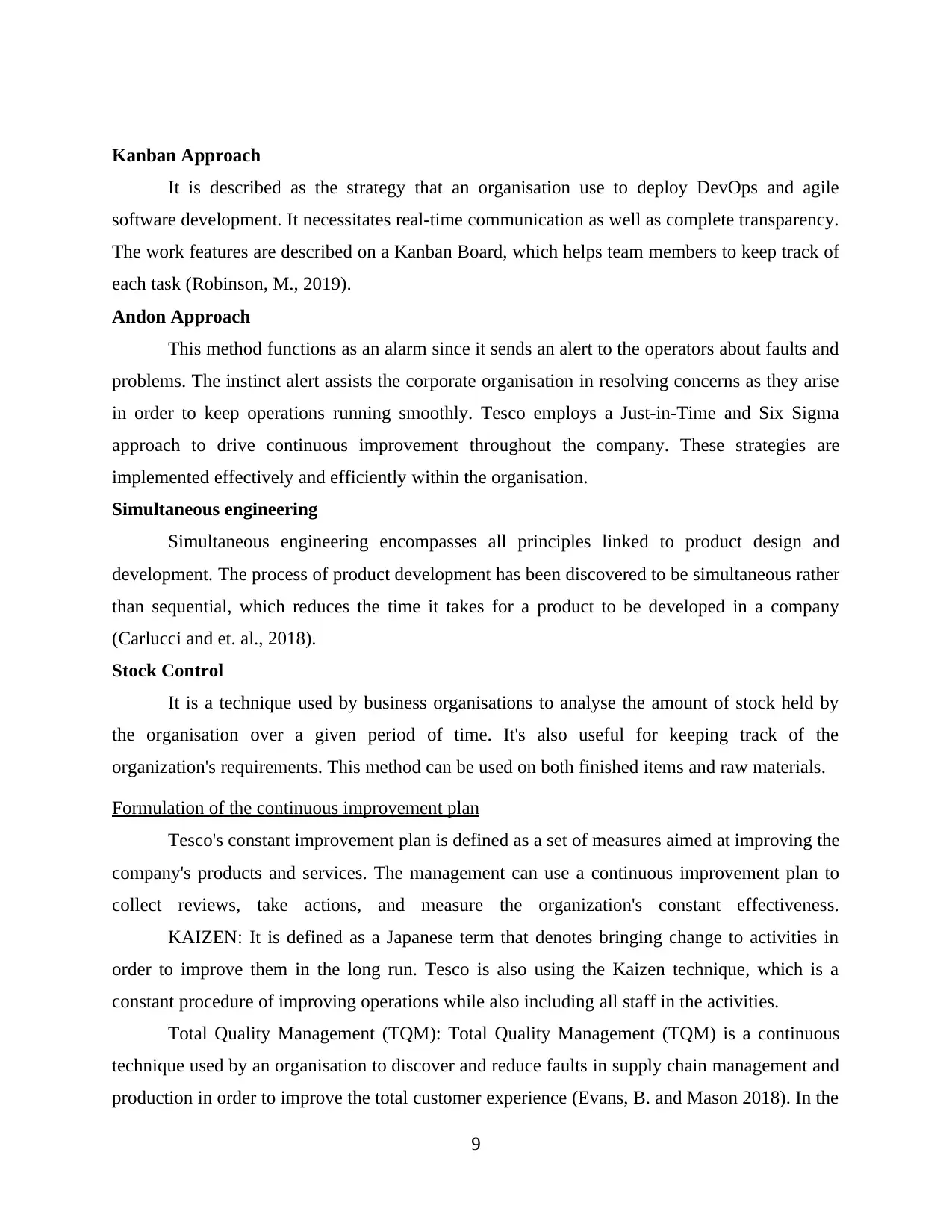
Kanban Approach
It is described as the strategy that an organisation use to deploy DevOps and agile
software development. It necessitates real-time communication as well as complete transparency.
The work features are described on a Kanban Board, which helps team members to keep track of
each task (Robinson, M., 2019).
Andon Approach
This method functions as an alarm since it sends an alert to the operators about faults and
problems. The instinct alert assists the corporate organisation in resolving concerns as they arise
in order to keep operations running smoothly. Tesco employs a Just-in-Time and Six Sigma
approach to drive continuous improvement throughout the company. These strategies are
implemented effectively and efficiently within the organisation.
Simultaneous engineering
Simultaneous engineering encompasses all principles linked to product design and
development. The process of product development has been discovered to be simultaneous rather
than sequential, which reduces the time it takes for a product to be developed in a company
(Carlucci and et. al., 2018).
Stock Control
It is a technique used by business organisations to analyse the amount of stock held by
the organisation over a given period of time. It's also useful for keeping track of the
organization's requirements. This method can be used on both finished items and raw materials.
Formulation of the continuous improvement plan
Tesco's constant improvement plan is defined as a set of measures aimed at improving the
company's products and services. The management can use a continuous improvement plan to
collect reviews, take actions, and measure the organization's constant effectiveness.
KAIZEN: It is defined as a Japanese term that denotes bringing change to activities in
order to improve them in the long run. Tesco is also using the Kaizen technique, which is a
constant procedure of improving operations while also including all staff in the activities.
Total Quality Management (TQM): Total Quality Management (TQM) is a continuous
technique used by an organisation to discover and reduce faults in supply chain management and
production in order to improve the total customer experience (Evans, B. and Mason 2018). In the
9
It is described as the strategy that an organisation use to deploy DevOps and agile
software development. It necessitates real-time communication as well as complete transparency.
The work features are described on a Kanban Board, which helps team members to keep track of
each task (Robinson, M., 2019).
Andon Approach
This method functions as an alarm since it sends an alert to the operators about faults and
problems. The instinct alert assists the corporate organisation in resolving concerns as they arise
in order to keep operations running smoothly. Tesco employs a Just-in-Time and Six Sigma
approach to drive continuous improvement throughout the company. These strategies are
implemented effectively and efficiently within the organisation.
Simultaneous engineering
Simultaneous engineering encompasses all principles linked to product design and
development. The process of product development has been discovered to be simultaneous rather
than sequential, which reduces the time it takes for a product to be developed in a company
(Carlucci and et. al., 2018).
Stock Control
It is a technique used by business organisations to analyse the amount of stock held by
the organisation over a given period of time. It's also useful for keeping track of the
organization's requirements. This method can be used on both finished items and raw materials.
Formulation of the continuous improvement plan
Tesco's constant improvement plan is defined as a set of measures aimed at improving the
company's products and services. The management can use a continuous improvement plan to
collect reviews, take actions, and measure the organization's constant effectiveness.
KAIZEN: It is defined as a Japanese term that denotes bringing change to activities in
order to improve them in the long run. Tesco is also using the Kaizen technique, which is a
constant procedure of improving operations while also including all staff in the activities.
Total Quality Management (TQM): Total Quality Management (TQM) is a continuous
technique used by an organisation to discover and reduce faults in supply chain management and
production in order to improve the total customer experience (Evans, B. and Mason 2018). In the
9
⊘ This is a preview!⊘
Do you want full access?
Subscribe today to unlock all pages.

Trusted by 1+ million students worldwide
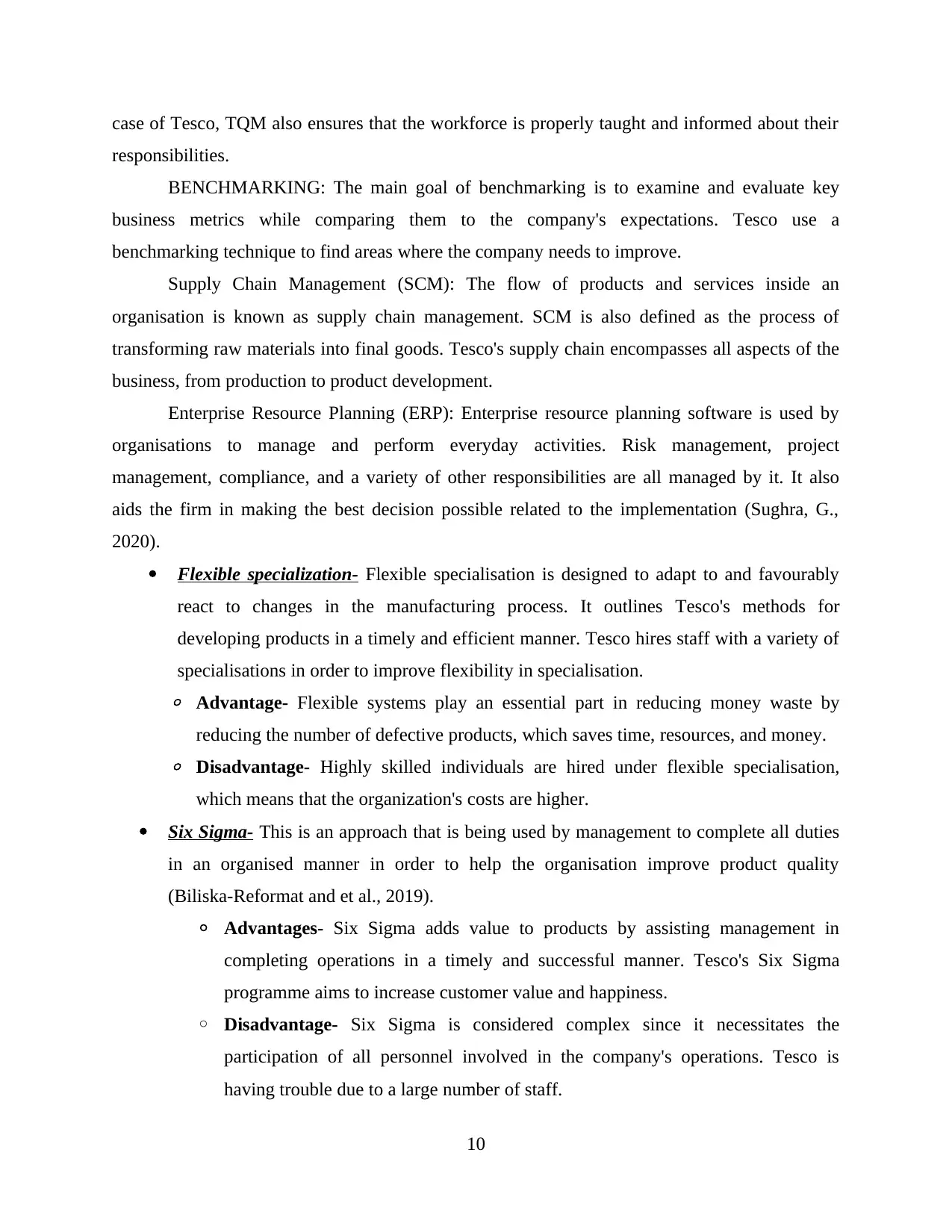
case of Tesco, TQM also ensures that the workforce is properly taught and informed about their
responsibilities.
BENCHMARKING: The main goal of benchmarking is to examine and evaluate key
business metrics while comparing them to the company's expectations. Tesco use a
benchmarking technique to find areas where the company needs to improve.
Supply Chain Management (SCM): The flow of products and services inside an
organisation is known as supply chain management. SCM is also defined as the process of
transforming raw materials into final goods. Tesco's supply chain encompasses all aspects of the
business, from production to product development.
Enterprise Resource Planning (ERP): Enterprise resource planning software is used by
organisations to manage and perform everyday activities. Risk management, project
management, compliance, and a variety of other responsibilities are all managed by it. It also
aids the firm in making the best decision possible related to the implementation (Sughra, G.,
2020).
Flexible specialization- Flexible specialisation is designed to adapt to and favourably
react to changes in the manufacturing process. It outlines Tesco's methods for
developing products in a timely and efficient manner. Tesco hires staff with a variety of
specialisations in order to improve flexibility in specialisation.
◦ Advantage- Flexible systems play an essential part in reducing money waste by
reducing the number of defective products, which saves time, resources, and money.
◦ Disadvantage- Highly skilled individuals are hired under flexible specialisation,
which means that the organization's costs are higher.
Six Sigma- This is an approach that is being used by management to complete all duties
in an organised manner in order to help the organisation improve product quality
(Biliska-Reformat and et al., 2019).
◦ Advantages- Six Sigma adds value to products by assisting management in
completing operations in a timely and successful manner. Tesco's Six Sigma
programme aims to increase customer value and happiness.
◦ Disadvantage- Six Sigma is considered complex since it necessitates the
participation of all personnel involved in the company's operations. Tesco is
having trouble due to a large number of staff.
10
responsibilities.
BENCHMARKING: The main goal of benchmarking is to examine and evaluate key
business metrics while comparing them to the company's expectations. Tesco use a
benchmarking technique to find areas where the company needs to improve.
Supply Chain Management (SCM): The flow of products and services inside an
organisation is known as supply chain management. SCM is also defined as the process of
transforming raw materials into final goods. Tesco's supply chain encompasses all aspects of the
business, from production to product development.
Enterprise Resource Planning (ERP): Enterprise resource planning software is used by
organisations to manage and perform everyday activities. Risk management, project
management, compliance, and a variety of other responsibilities are all managed by it. It also
aids the firm in making the best decision possible related to the implementation (Sughra, G.,
2020).
Flexible specialization- Flexible specialisation is designed to adapt to and favourably
react to changes in the manufacturing process. It outlines Tesco's methods for
developing products in a timely and efficient manner. Tesco hires staff with a variety of
specialisations in order to improve flexibility in specialisation.
◦ Advantage- Flexible systems play an essential part in reducing money waste by
reducing the number of defective products, which saves time, resources, and money.
◦ Disadvantage- Highly skilled individuals are hired under flexible specialisation,
which means that the organization's costs are higher.
Six Sigma- This is an approach that is being used by management to complete all duties
in an organised manner in order to help the organisation improve product quality
(Biliska-Reformat and et al., 2019).
◦ Advantages- Six Sigma adds value to products by assisting management in
completing operations in a timely and successful manner. Tesco's Six Sigma
programme aims to increase customer value and happiness.
◦ Disadvantage- Six Sigma is considered complex since it necessitates the
participation of all personnel involved in the company's operations. Tesco is
having trouble due to a large number of staff.
10
Paraphrase This Document
Need a fresh take? Get an instant paraphrase of this document with our AI Paraphraser
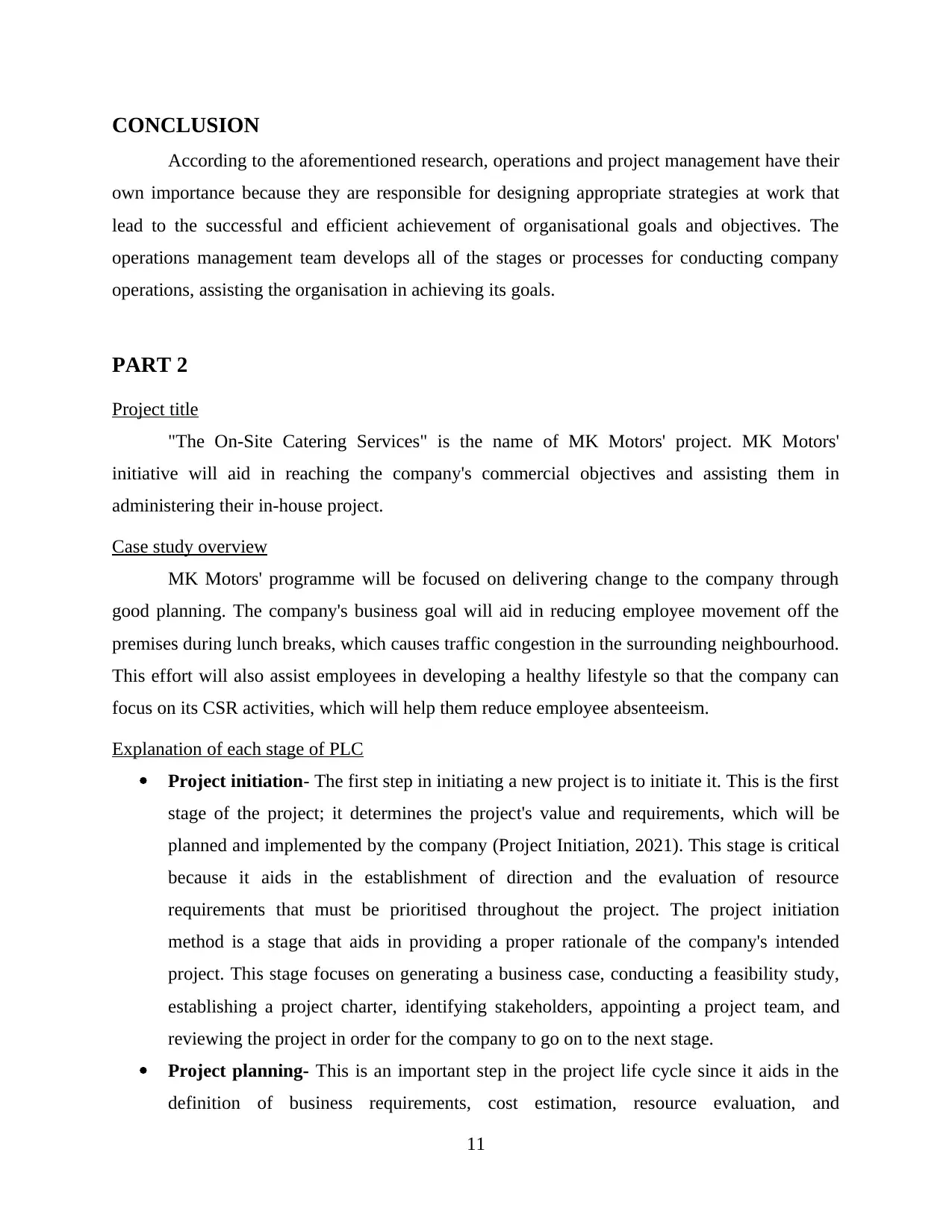
CONCLUSION
According to the aforementioned research, operations and project management have their
own importance because they are responsible for designing appropriate strategies at work that
lead to the successful and efficient achievement of organisational goals and objectives. The
operations management team develops all of the stages or processes for conducting company
operations, assisting the organisation in achieving its goals.
PART 2
Project title
"The On-Site Catering Services" is the name of MK Motors' project. MK Motors'
initiative will aid in reaching the company's commercial objectives and assisting them in
administering their in-house project.
Case study overview
MK Motors' programme will be focused on delivering change to the company through
good planning. The company's business goal will aid in reducing employee movement off the
premises during lunch breaks, which causes traffic congestion in the surrounding neighbourhood.
This effort will also assist employees in developing a healthy lifestyle so that the company can
focus on its CSR activities, which will help them reduce employee absenteeism.
Explanation of each stage of PLC
Project initiation- The first step in initiating a new project is to initiate it. This is the first
stage of the project; it determines the project's value and requirements, which will be
planned and implemented by the company (Project Initiation, 2021). This stage is critical
because it aids in the establishment of direction and the evaluation of resource
requirements that must be prioritised throughout the project. The project initiation
method is a stage that aids in providing a proper rationale of the company's intended
project. This stage focuses on generating a business case, conducting a feasibility study,
establishing a project charter, identifying stakeholders, appointing a project team, and
reviewing the project in order for the company to go on to the next stage.
Project planning- This is an important step in the project life cycle since it aids in the
definition of business requirements, cost estimation, resource evaluation, and
11
According to the aforementioned research, operations and project management have their
own importance because they are responsible for designing appropriate strategies at work that
lead to the successful and efficient achievement of organisational goals and objectives. The
operations management team develops all of the stages or processes for conducting company
operations, assisting the organisation in achieving its goals.
PART 2
Project title
"The On-Site Catering Services" is the name of MK Motors' project. MK Motors'
initiative will aid in reaching the company's commercial objectives and assisting them in
administering their in-house project.
Case study overview
MK Motors' programme will be focused on delivering change to the company through
good planning. The company's business goal will aid in reducing employee movement off the
premises during lunch breaks, which causes traffic congestion in the surrounding neighbourhood.
This effort will also assist employees in developing a healthy lifestyle so that the company can
focus on its CSR activities, which will help them reduce employee absenteeism.
Explanation of each stage of PLC
Project initiation- The first step in initiating a new project is to initiate it. This is the first
stage of the project; it determines the project's value and requirements, which will be
planned and implemented by the company (Project Initiation, 2021). This stage is critical
because it aids in the establishment of direction and the evaluation of resource
requirements that must be prioritised throughout the project. The project initiation
method is a stage that aids in providing a proper rationale of the company's intended
project. This stage focuses on generating a business case, conducting a feasibility study,
establishing a project charter, identifying stakeholders, appointing a project team, and
reviewing the project in order for the company to go on to the next stage.
Project planning- This is an important step in the project life cycle since it aids in the
definition of business requirements, cost estimation, resource evaluation, and
11
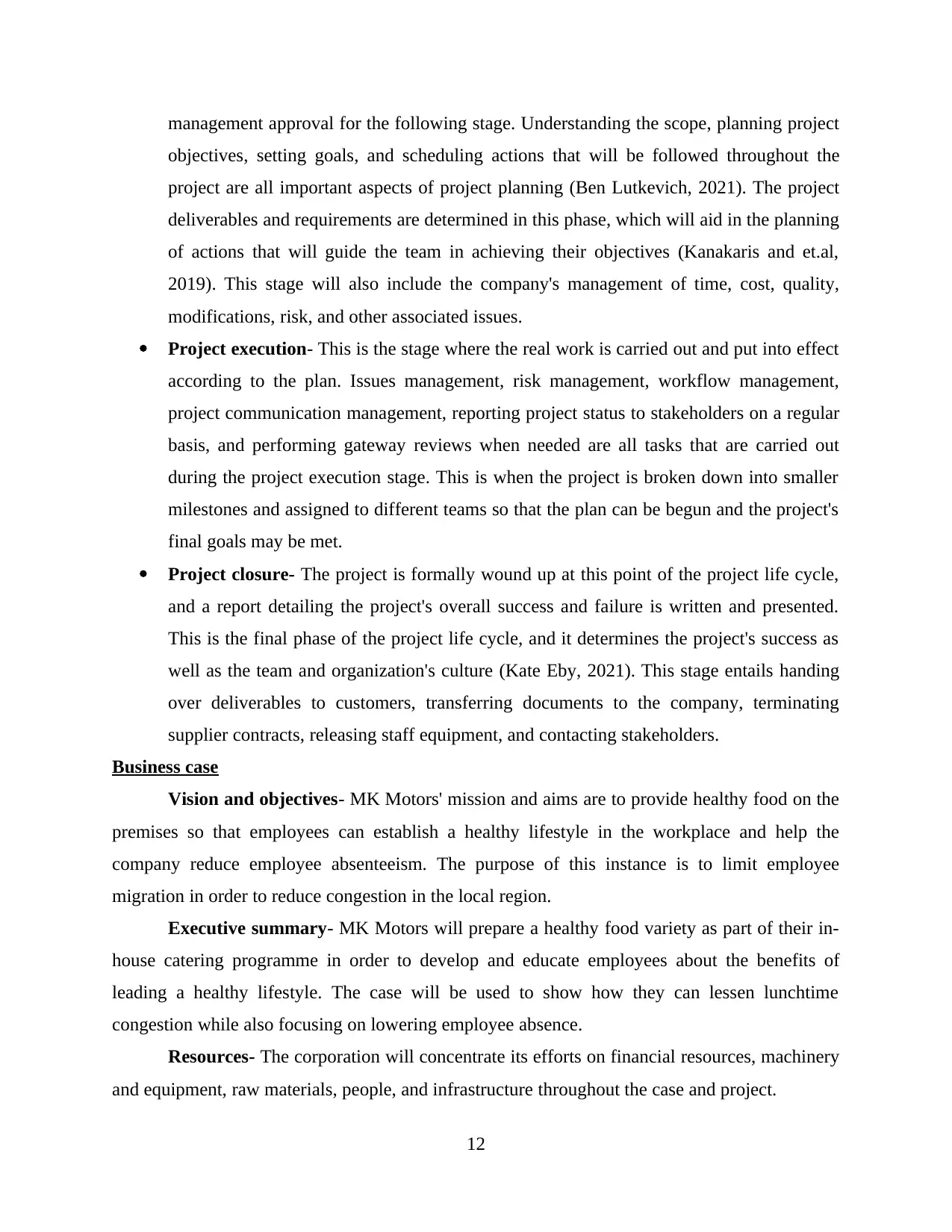
management approval for the following stage. Understanding the scope, planning project
objectives, setting goals, and scheduling actions that will be followed throughout the
project are all important aspects of project planning (Ben Lutkevich, 2021). The project
deliverables and requirements are determined in this phase, which will aid in the planning
of actions that will guide the team in achieving their objectives (Kanakaris and et.al,
2019). This stage will also include the company's management of time, cost, quality,
modifications, risk, and other associated issues.
Project execution- This is the stage where the real work is carried out and put into effect
according to the plan. Issues management, risk management, workflow management,
project communication management, reporting project status to stakeholders on a regular
basis, and performing gateway reviews when needed are all tasks that are carried out
during the project execution stage. This is when the project is broken down into smaller
milestones and assigned to different teams so that the plan can be begun and the project's
final goals may be met.
Project closure- The project is formally wound up at this point of the project life cycle,
and a report detailing the project's overall success and failure is written and presented.
This is the final phase of the project life cycle, and it determines the project's success as
well as the team and organization's culture (Kate Eby, 2021). This stage entails handing
over deliverables to customers, transferring documents to the company, terminating
supplier contracts, releasing staff equipment, and contacting stakeholders.
Business case
Vision and objectives- MK Motors' mission and aims are to provide healthy food on the
premises so that employees can establish a healthy lifestyle in the workplace and help the
company reduce employee absenteeism. The purpose of this instance is to limit employee
migration in order to reduce congestion in the local region.
Executive summary- MK Motors will prepare a healthy food variety as part of their in-
house catering programme in order to develop and educate employees about the benefits of
leading a healthy lifestyle. The case will be used to show how they can lessen lunchtime
congestion while also focusing on lowering employee absence.
Resources- The corporation will concentrate its efforts on financial resources, machinery
and equipment, raw materials, people, and infrastructure throughout the case and project.
12
objectives, setting goals, and scheduling actions that will be followed throughout the
project are all important aspects of project planning (Ben Lutkevich, 2021). The project
deliverables and requirements are determined in this phase, which will aid in the planning
of actions that will guide the team in achieving their objectives (Kanakaris and et.al,
2019). This stage will also include the company's management of time, cost, quality,
modifications, risk, and other associated issues.
Project execution- This is the stage where the real work is carried out and put into effect
according to the plan. Issues management, risk management, workflow management,
project communication management, reporting project status to stakeholders on a regular
basis, and performing gateway reviews when needed are all tasks that are carried out
during the project execution stage. This is when the project is broken down into smaller
milestones and assigned to different teams so that the plan can be begun and the project's
final goals may be met.
Project closure- The project is formally wound up at this point of the project life cycle,
and a report detailing the project's overall success and failure is written and presented.
This is the final phase of the project life cycle, and it determines the project's success as
well as the team and organization's culture (Kate Eby, 2021). This stage entails handing
over deliverables to customers, transferring documents to the company, terminating
supplier contracts, releasing staff equipment, and contacting stakeholders.
Business case
Vision and objectives- MK Motors' mission and aims are to provide healthy food on the
premises so that employees can establish a healthy lifestyle in the workplace and help the
company reduce employee absenteeism. The purpose of this instance is to limit employee
migration in order to reduce congestion in the local region.
Executive summary- MK Motors will prepare a healthy food variety as part of their in-
house catering programme in order to develop and educate employees about the benefits of
leading a healthy lifestyle. The case will be used to show how they can lessen lunchtime
congestion while also focusing on lowering employee absence.
Resources- The corporation will concentrate its efforts on financial resources, machinery
and equipment, raw materials, people, and infrastructure throughout the case and project.
12
⊘ This is a preview!⊘
Do you want full access?
Subscribe today to unlock all pages.

Trusted by 1+ million students worldwide
1 out of 19
Related Documents
Your All-in-One AI-Powered Toolkit for Academic Success.
+13062052269
info@desklib.com
Available 24*7 on WhatsApp / Email
![[object Object]](/_next/static/media/star-bottom.7253800d.svg)
Unlock your academic potential
Copyright © 2020–2025 A2Z Services. All Rights Reserved. Developed and managed by ZUCOL.


